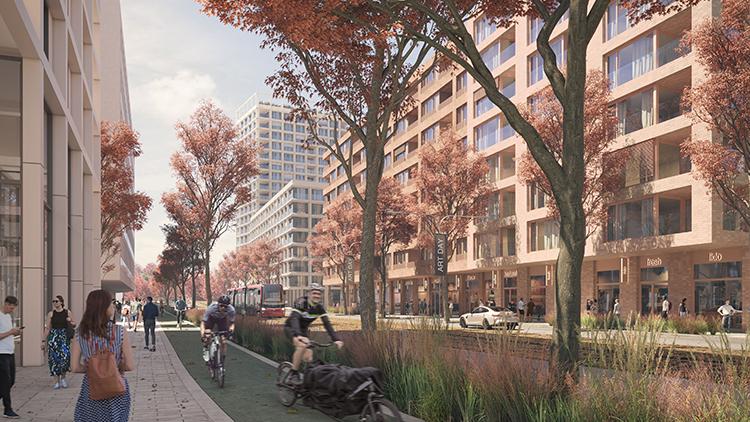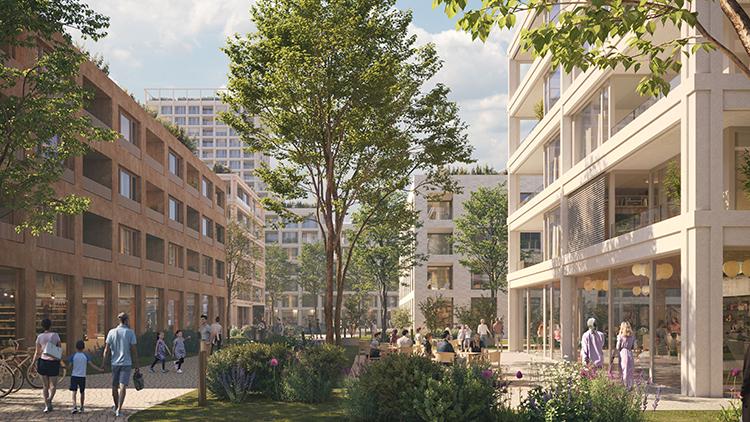Bratislava's Nové Lido urban district aims for carbon neutrality
Nové Lido urban district aims to rejuvenate the area between Old Bridge and Apollo Bridge in Petržalka, a project with ten years’ planning that will expand Bratislava city centre on the Danube’s right bank. This will build on the area’s historical identity, while also setting new ecological and community standards for Slovakia and CEE. Ongoing BREEAM Communities International certification confirms our commitment to sustainably develop this zone in the heart of the city.
Mixed-use Nové Lido will provide housing, civic amenities, 20,000 job opportunities, large and high-quality green public spaces, and good connections to the Bratislava districts of Petržalka, Staré Mesto and Ružinov. “By optimally combining functions, we create a 15-minute city where everything is within reach. Bratislava’s residents and visitors will be attracted by the services and opportunities for relaxation, entertainment, sport, and the riverside area. Residences are centrally orientated towards the Danube, while civic amenities are thoughtfully interspersed throughout, and job opportunities and administration section are concentrated along the Einsteinova corridor," observes Pavel Pelikán, JTRE’s executive director.
This exciting new urban district’s design results from long-term cooperation between JTRE and leading national and international architects, urban planners, landscape architects, and consultants specialising in social responsibility, sustainability, ecology, sociology and green tech. The visionaries behind the urban study are Juraj Benetin and Compass Architekti studio, as well as Jakub Cigler architects and urban planners, Marko & Placemakers, Gehl Architects, and GFI.
"The development’s intensity and density corresponds to an efficient compact city center with a block structure and lower average number of floors and higher built-up area," explains architect Juraj Benetin. "Nové Lido is where the new downtown centre can unite with the Danube’s right bank to connect Petržalka with the Old Town and Ružinov.”
Bratislava’s long-term development strategies, as reflected in the city’s contemporary spatial plan - reflects this vision. Nové Lido’s design is based on principles such as multi-functionality, compact block development with tranquil courtyards, north-south urban grid with views of the city’s landmarks and surrounding landscape, a central park, and footbridge over the Danube.
The project also seeks to update and reinvigorate a spatial plan that was approved almost 20 years ago. The result will be a strengthening of the area’s urbanity, preservation and protection of the Danube floodplain forest, and increasing urban greenery behind the water barrier by over a third. This approach will enable the development of river-based sport and the return of the once popular Lido city beach. "A bypass channel would negatively impact the existing habitat of floodplain forests. Instead, our planned riverside park will boost the connection between Bratislava residents and the Danube," adds Benetin.
The riverside left bank’s Štefánik Square flanked by the Slovak National Theatre will be organically reflected on the Nové Lido right side with a central square and key multi-functional building. Public spaces of both banks of Bratislava’s new centre will have visual continuity and physical connection via an attractive footbridge. The square will lead from the embankment through the central park to a city boulevard with avenues of trees, bike path, large space for pedestrians, and opportunity to incorporate a tram line.
Vehicular traffic from Einsteinova Street will be orientated towards underground car parking in order to promote quality of air and tranquility in the urban area and riverside zone. Public transport and walking will be positively promoted, and cycling will follow the existing popular Eurovelo 6 and Chorvátske rameno routes.
"Since day one, Nové Lido has aimed to hugely reduce or eliminate emissions to move towards carbon neutrality and create a high-quality and healthy environment," explains Martin Stohl, JTRE’s ESG manager.
Hence the project’s focus on emission-free renewable energy – such as thermal, hydro, and solar. Innovative tech will positively impact living and working through the provision of a pleasant and healthy outdoor environment – with ‘heat islands’ mitigated through the use of greenery, shading, appropriate materials, and rainwater collection. A sustainable and climate-safe neighbourhood is a long-term project – with staged construction over 10 to 15 years. "The current rate of global warming means that cooling will become increasingly important – both for interiors and public spaces. We design these to promote well-being and enjoyable free-time, even as the climate potentially worsens," adds Stohl.
The project and its energy concept are based on expert studies. These include energy efficiency and emission reduction, ecological materials, local renewable energy sources, biodiversity, microclimate, and demographic/economic impacts. The international expert team includes Slovaks, Czechs, Dutch, Austrians, and Scandinavians. These studies have enabled the project to apply for prestigious BREEAM Communities green certification, which is also significantly intertwined with the Bratislava 2030 strategic vision (Metropolitan Institute of Bratislava). Only six projects in CEE have so far received this prestigious rating.
“BREEAM Communities consider a whole area rather than specific buildings. We’ve just completed the first of the certification’s three steps: preparation of the project’s urban concept; criteria for ecology, biodiversity, etc.; and overall impact on the specific city part - including the promotion of existing and new communities," explains Stohl.
Nové Lido’s construction plans are at the environmental impact assessment (EIA) stage. The area’s spatial plan is also being updated, with last year’s public hearing proposals for amendments and additions being evaluated by the Capital City Municipality.










